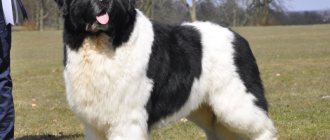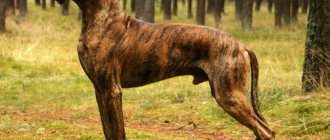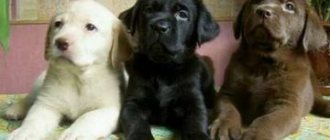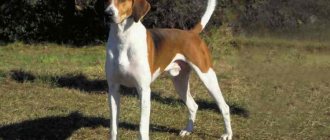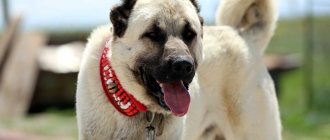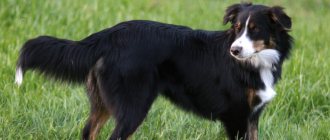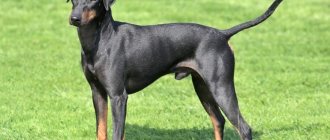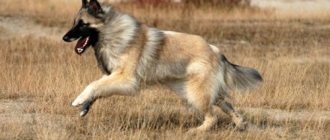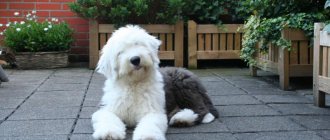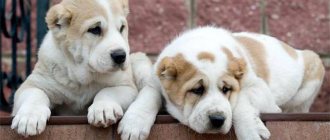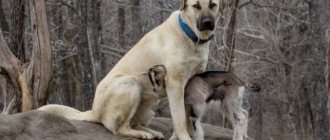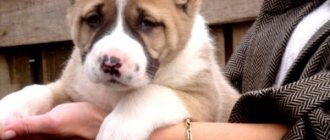Find out more about the Tatra or Polish Podgalian Shepherd dogs. The article provides interesting facts from the history of the appearance of the breed. You will also find out why these large dogs are used in canistherapy to work with special children and why dog dogs are recruited to serve in special forces. You can watch an interesting video about the non-standard education of the Podgalian Shepherd, as well as a series of interesting and fascinating photos with representatives of the Polish Podhalian Shepherd Dog breed, which will help you to consider the characteristic exterior of these snow-white giants.
Origin
There are several versions of the origin of the Tatra dog (the second name for the Podgalyan Shepherd Dog).
The first tells that its roots go back to antiquity. The Polish Shepherd is considered the oldest breed. Looking at the power and appearance of the representatives of the breed, breeders long ago came to the conclusion: in the family of Tatra Shepherd Dogs there were Tibetan mastiffs. The ancestors of the Polish dog found themselves in Europe in the 4th-6th centuries BC. They came along with the Huns and Avars.
The second legend tells about cruel nomadic tribes. They moved from Tibet to the Tatras, destroying everyone in their path. The nomads were accompanied by huge and very ferocious dogs. In appearance, the animals resembled bears, and their cruelty was indescribable. Dogs guarded nomadic tribes. Soon the nomads settled in the Tatras, and their pets remained next to them. People needed to survive, and the active development of sheep farming began. The climate in the Tatra Mountains was not particularly comfortable. The dogs were required to have maximum adaptability to mountainous terrain, herding and guarding skills.
Polish Podgalian Sheepdogs helped herd and guard flocks of sheep
What is it for?
The Tatra Shepherd Dog has guarding qualities from birth, being the most vigilant guardian of the owner’s property and home. The appearance of the representatives of the breed inspires not only respect due to their large size, but also fear. The Poles only occasionally used the animal as a herder . The main activity of the dog was to guard property and also to transport cargo to its destination. Podgalyanoks are also involved in guard duty, where they valiantly guard places of detention, keeping an eye on the prisoners.
The Poles call this breed nothing more than the Tatra Mountain Dog. She is gladly accepted into the ranks of special forces rescuers. In emergency situations, large powerful creatures help save people. Its kind disposition and boundless adoration for children allows this dog to be used in a canistherapy program to work with children with disabilities.
Breed standard, description and color
The Polish Podgalian Sheepdog received its own description less than a century ago. This breed is ancient, but not aboriginal. It was modified as a result of breeding work.
The first exhibition of representatives of the breed took place in 1937. The zootechnical event took place in Zakopane, at the foot of the Tatra Mountains. It was here that the first breed standard was developed.
Head
Dry and strong, the skull is rounded. The transition from forehead to muzzle is not clearly expressed. The muzzle is long, tapering towards the bottom. The ears are thick, of medium length, “semi-dropping”. The eyes are very expressive, dark brown in color. The nose is large and black. Lips are dry and tight. Scissor bite.
Torso
According to the breed description, the dogs have a muscular neck. The body is long, the withers are pronounced. The back is wide, the chest is deep, the loin is long. The croup is sloping. The stomach is taut. The tail is low set and reaches the hock joint.
Forelegs
Muscular and long. The paws are oval, the pads are hard. The claws are dark in color.
Hind limbs
Slightly pulled back when looking at the dog from the side. Long. Paws are oval shaped with hard pads. The claws are dark.
Wool
On the muzzle and paws it is short and thick. The undercoat is well developed. The wool is soft to the touch. The body is covered with long, wavy hair with a dense undercoat.
Color
Let's say white. Light spots are considered a deviation from the standard.
Height and weight
The Podgalyan Shepherd Dog is a large dog. The minimum height of a male dog is 65 centimeters. Females are smaller - 60 centimeters. The weight of representatives of both sexes reaches 70 kilograms.
Podgalyansky Shepherd dog standing
Breed characteristics
| Short description | |
| Origin: | Poland |
| Conditions of detention: | Yard, aviary |
| Purpose: | Cattle dog, guard, companion |
| Color: | White, cream |
| Wool length: | Average |
| Adult dog size: | The height of the female is 60-65 cm, the male is 65-70 cm; male weight – 55-70 kg, female – 45-55 kg |
| Average life expectancy: | 12-16 years old |
| Walk: | Twice active walking is required |
| Physical activity needs: | High physical activity needs (workouts, games, jogging) |
| Fédération Cynologique Internationale (FIC) classification: | Group 1: herding and cattle dogs except Swiss cattle dogs; section 1: shepherd dogs |
| Puppy price: | Without pedigree – 30-35 thousand rubles; pet class – up to 50 thousand rubles; breed class – 70-80 thousand rubles; show class - up to 120 thousand rubles. |
Character and characteristics of the breed
The main advantage of Polish dogs is their temperament. Representatives of the breed seem to be phlegmatic: reactions are inhibited, the pet gives the impression of being eternally sleepy. This is a deep misconception. An adult dog is constantly on guard. The breeders and owners of these dogs assure that their pets are on “high alert” for 24 hours. Imaginary sleepiness is the ability to conserve your energy. The shepherd dog controls the territory entrusted to it so skillfully that a stranger looking at the light will not understand this.
The breed's characteristics include the ability to make independent decisions. Its origins lie in ancient times, when snow-white dogs had to protect nomadic tribes from predators.
Polish Shepherds are agile, attentive and efficient. The character can be described as follows: typical sanguine people. The processes of excitation and inhibition are equally developed. The dogs were bred for protection, and their intelligence and fearlessness are not surprising.
The Podgalyan Shepherd Dog is affectionate with members of the household. She has only one owner. Usually the pet's heart is given to the head of the family. He will listen to him unquestioningly. Earning a dog's respect is not easy. The owner must have leadership qualities, be able to find contact with the dog and influence it only morally. Descendants of mastiffs hate violence against themselves. They were bred to serve people. And this does not mean that a person can influence a dog physically. The dog is capable of giving a cruel and decisive rebuff. The Podgalyansky dog attacks instantly, without warning.
The Podgalyan Shepherd chooses only one family member as its leader
These animals require socialization from early childhood. The puppies look very touching, a teddy white bear. You can forgive him a lot for his appearance. Trouble will come when the pet grows up. An ill-mannered dog, slightly smaller than a calf, is a living killing machine. Considering the disposition of the representatives of the breed, their ability to make decisions independently, training and socialization should be present in the life of the Podgalyansky dog from puppyhood.
IMPORTANT! The Podgalyan Shepherd is a large breed with a difficult character.
Attitude towards people, children and pets
A Polish shepherd appeared in the house, and friends unanimously refused to come visit. In vain, a dog will not injure a person without a command. If he does not pose a threat to her and the owner’s family members. The animal sees that the owner calmly communicates with strangers. It will patiently monitor the actions of outsiders. In the presence of the owner, nothing threatens the guests except close attention from the dog. You shouldn't leave them alone with their faithful guardian. A brave guest may suddenly rise from his chair, wave his hand, or laugh loudly. The dog will perceive his actions as a threat to himself. There will be big troubles.
Representatives of the breed are patient with children. Some owners believe that their dogs are wonderful nannies. This is not so, representatives of the breed will not offend a child, they allow the little person to do whatever he wants to them. But the qualities inherent in the descendants of mastiffs are far from conducive to making them nannies for babies.
Podgalyan Shepherd Dogs are very tolerant of children.
Loyal to pets. The ideal option for their peaceful existence would be if the dog settled in the family later than other four-legged inhabitants. The puppy was brought into a house where a cat already lived. They are completely indifferent to other dog breeds. Since ancient times, Polish Shepherds lived in a pack and served together. The presence of dogs does not bother them.
How to raise and train
A person who wants to raise this dog must learn to restrain his negative emotions and not offend his pupil. It is important to establish and maintain an even, friendly relationship with him from the very beginning.
Read Description of the Austrian Smooth-haired Pinscher breed
Rudeness and irritability are categorically unacceptable when communicating with an animal. At the same time, the dog must feel the indisputability of the owner’s will; firmness and strength of character combined with friendliness. Manifestations of weakness and rudeness are equally unacceptable.
Training begins at two months of age. At the first stage, the puppy must be accustomed to life outside the enclosure, yard, or home. He needs to be walked three to four times a day, even if he enjoys freedom within the area. The route needs to be varied; introduce the dog to new territories, other animals, people. It is necessary to accustom him to sharp sounds, unusual noises, and smells.
Classes should be conducted systematically and be interesting. Learning is built in development from simple to complex; You should not overtire the puppy; it is advisable to alternate the lesson phase with rest, giving him the opportunity to run or lie in the grass.
The duration of the lesson at the first stage is no more than 60 minutes.
Proper upbringing will provide your pet with a comfortable transition into adulthood, eliminating fearfulness and aggressiveness.
Security qualities
The herding Polish Shepherd has very developed guarding qualities. This dog is on duty around the clock. She sleeps lightly; the slightest rustle makes the representative of the breed wary.
Suspicious of strangers. Without a command, he will touch in one case: a stranger poses a danger to family members or to the dog himself.
If the owners of the house and someone comes to visit, the dog will watch. The guest appeared in the absence of household members, then an extremely unfriendly reception awaits him.
IMPORTANT! The ideal guard. Representatives of the breed feel comfortable in a large enclosure on the territory of a private house.
Choosing a Podgalian Polish Shepherd puppy
The Polish Shepherd is a relatively rare breed. Interestingly, it is more popular in the Netherlands and America than in its homeland, where it had to give way to more fashionable breeds. Single nurseries of Podgalians can be found in most European countries. Often there are advertisements for the sale of puppies from individuals, owners of shepherd dogs who, for some reason, decided to breed. These can be identified immediately based on price. Most puppies from amateur litters do not have documents about their origin, and the parents may be carriers of hereditary diseases, which are always kept silent.
One of the most common diseases in the breed is hip dysplasia, so it is advisable for parents to be tested for this disease. Confirmation is provided by x-rays taken at more than one year of age. Also, the parents of the litter must have diplomas of completion of obedience courses OKD, dog in the city and the like.
Puppies and the mother of the offspring should look healthy, active, and of normal nutrition. They evaluate the living conditions of the dogs, the quality of feeding and the ability to spend a lot of time in free movement. This is necessary for the proper formation of the musculoskeletal system. Already at 2 months, babies meet the standard in many respects; you can evaluate the bite, ear set, paw strength, body format, and more. Purebred puppies are distinguished by a brand and a puppy card. They must also have a personal veterinary passport with vaccination records according to age; a chip is required only for transportation.
Price
The average cost of a Polish Shepherd puppy from a kennel is 50,000 rubles. Sometimes promising babies from imported elite producers can cost significantly more. There are also advertisements for the sale of Podgalians at a price of 15,000-20,000 rubles. Usually these are puppies obtained as a result of an unscheduled mating, they do not have documents and in the canine world are considered outbred.
Puppies
In Russia, the Podgalyan Shepherd Dog is not as popular as in Canada or the USA. There she is used for police work. The demand for puppies is high.
You should buy a baby when he is 2-2.5 months old. The Polish dog has a strong psyche, but a little checking will not hurt.
A puppy can be adopted at the age of no earlier than 2-2.5 months, so that strong immunity can be formed.
The simplest thing is to throw a bunch of keys next to the puppies and observe the reaction. If the baby jumps to the side in fear, this is not a guard. Mentally weak. Stands still and looks at the object without trying to run away - a good dog will grow up. With a loud bark he rushes to the keys, the dog can grow overly aggressive.
Who is better to choose? Bitches are more people-oriented. Their guard qualities are weaker. Males are larger and more aggressive, and will guard conscientiously.
Socialization and training
Like any native dog, formed naturally, the Polish Podgalian Sheepdog is perfectly adapted to life in the open air. In the natural environment it is able to find food. The dog's size and strength allow it to win in single combat with a wolf; its thick coat helps it not to freeze on cold, long winter nights. A dog is able to survive without human intervention.
It is better to keep the Podgalyan Shepherd Dog in the yard, where it can exercise its guarding abilities. It is acceptable to keep it in an apartment, but you will need to walk often and for a long time, it is better outside the city, where you can let the dog run around without a leash. Then the dog receives a balanced load on the body and joints. Most shepherd dogs, including Tatra dogs, live in a dual mode: in winter - in an apartment with their owners, in summer - in the country, where they go with pleasure. Shepherd dogs do not have “digging mania”; the vegetable garden and flower beds will not be damaged.
The snow-white Polish Shepherd gets along well with family members and is an excellent nanny. The Podgalyan Shepherd Dog has retained its pack instinct, therefore, the more people there are in the family, the better for the dog. It is possible to safely leave the child with the dog. The dog will not touch the baby and will protect it from the attacks of strangers.
People are known to choose a dog to put on a chain. A chain does not decorate any dog, nor the owner. Chaining a Tatra Shepherd is tantamount to cruelty and abuse of the animal. The Podgalian will become sad, the dog’s character will deteriorate, and serious health problems will appear.
The Podgalyan Shepherd Dog does not deserve rude treatment and does not tolerate this kind of behavior. The dog does not tolerate coercion; if you behave incorrectly with the pet, it will show remarkable stubbornness.
In order for training and training to be easy and relaxed, the owner will have to establish a trusting relationship with the pet. There is no point in teaching your pet security skills. In dogs, these skills are innate and strongly expressed. They intuitively know how to defend and secure the territory.
The training of the Polish Podgalian Shepherd Dog is carried out gradually. Sufficient independence in the pet’s character should be taken into account. It is advisable to make a special door for the dog, leaving the opportunity to go for a walk or relieve its natural needs on its own.
Animals are suspicious of strangers and strangers. Do not express aggression or dissatisfaction. You should not think that a shepherd will ignore strangers. Even when playing or minding its own business, the dog will begin to become restless and constantly watch strangers. Dogs use their teeth only in cases of extreme necessity and will not warn about this by barking.
Training and education
The Podgalyansky Shepherd Dog requires discipline from childhood. If the owner spoils the puppy, it will not end well. Raising a male dog must be approached in a more strict manner than raising a female dog.
Golden rules for dog owners:
- consistency in actions and patience;
- everything happens gradually. They move from simple to complex;
- use inhibitory commands less;
- eliminate physical impact on the pet;
- if you want to raise your voice, then bite your tongue;
- remember that a dog is a reflection of its owner. She is not bad and stupid. The owner couldn't teach.
We work with the puppy every day. A few minutes with intervals between workouts. As the dog gets older, the load on it also increases.
Key points in training
It is important to maintain a balance when training a Tatra. The owner must be strict, demanding and serious, but always respect boundaries and not allow himself to hit, insult or shout at the dog. Shepherd dogs have developed intelligence, they understand the first time, but they need a leader - a leader. At the same time, they do not like to obey the weak, and react to aggression with aggression.
For training to proceed quickly and be effective, the owner and the pet must establish moral contact. You can teach a dog to trust only if you spend a lot of time with it.
Podgalians are guards from birth. They do not need to further develop their defense skill. But learning to control emotions and make decisions independently is a learning task.
Read a detailed article on the topic: “Everything you need to know about breeding dogs: appropriate age, what to do if it doesn’t work out, rules and tips.”
Maintenance, care and feeding
The Polish Shepherd reaches large sizes. The breed is absolutely not an apartment breed. She will perceive the limited space as her own booth. Constantly being in a confined area puts pressure on the animal. The dog becomes aggressive and irritable. Walking with such a pet in the city is problematic. He may decide that this passerby waving his arms is a source of danger. And immediately begin to act, without waiting for the owner’s instructions.
It is much more difficult to train a male dog than a female dog.
The ideal option for keeping a Podgalyansky dog is a large country house with a spacious enclosure. A representative of the breed should be able to move a lot; the dog is quite energetic.
The dog does not require special care. Its snow-white color is not a reason for frequent bathing. Attention is paid to wool. You need to comb your pet 4-5 times a week. During molting periods - daily.
You should examine your mouth, ears, and eyes every day. Brushing your teeth is done with regular apples. If a dog eats this fruit every day, he will not be at risk of plaque.
Discharge from the eyes is removed with a cotton swab dipped in water. The ears are cleaned with cotton swabs.
The dog's diet consists of meat, cereals, vegetables, dairy products and fruits. The Polish Shepherd is allowed:
- lean meat;
- rice or buckwheat;
- boiled cabbage, carrots, zucchini, some beets, some potatoes;
- low-fat kefir, low-fat cottage cheese;
- unleavened apples for cleaning teeth;
- boiled chicken or quail eggs;
- sugar beef bones occasionally.
The second food option is dry food. Super - premium class or holistic.
IMPORTANT! Caring for a Polish Shepherd is not difficult. You just need to brush your dog regularly.
Feeding your pet
Before purchasing a puppy, think about the dog's nutrition. Choose the option that suits your pet's feeding needs. When choosing between dry food and natural products, evaluate your own capabilities. A small dog eats 6 times a day; an adult dog needs to be fed twice a day.
If you choose dry food, adhere to the following points:
- Buy premium food. Their composition is balanced and contains essential vitamins and minerals.
- When giving your pet a balanced dry diet, you should not add additional vitamins or mineral supplements to the food.
- When giving the daily dose, follow the instructions. Do not overfill the bowl with food.
- Remember, dry food makes you very thirsty; always place a bowl of clean water nearby.
You cannot feed your animal dry food and natural products at the same time. It is not recommended to give your dog food from the owner's table. Such complementary feeding will cause disturbances in the shepherd’s digestion.
Nutrition
Due to its large size and high activity, the Polish Shepherd must eat properly. Dry types of food and natural products prepared at home are equally suitable as food. It is important to know that you should not mix both types of food, as this can lead to digestive problems for the dog. Natural nutrition should consist of lean meat, cottage cheese, chicken and quail eggs, fresh vegetables and fruits, and boiled cereals.
As a treat, you can sometimes give small amounts of yogurt and cheese. When choosing purchased food, you should pay attention to the manufacturer and the intended use for certain breeds of dogs.
Diseases
Nature itself raised Podgalyan Shepherd Dogs in the vast expanses at the foot of the mountains, where climatic conditions are far from the most favorable. Over many centuries, dogs have developed immunity to many diseases. However, some health problems may also arise in the Podgalyan Shepherd Dog:
- Hip dysplasia (a genetic disease often found in large breed dogs).
- Digestive problems (associated with poor nutrition, sudden changes in food).
Features of the content of the hem
The Podgalyanets is a serious pet; living in a city apartment would make it difficult for a dog to live. He needs a lot of space, constant walking, and physical activity. It is not recommended to limit the dog, that is, keeping it on the fetch is not natural for it, and - for which the dog will suffer.
- Better conditions are a heated, spacious enclosure that will not be completely closed, leaving the opportunity for natural movement.
- A warm, spacious booth, without a leash, with the ability to move around the entire territory.
If a dog lives on the street, this does not mean that he does not require additional walking
For pooches, it is important to spend time not only in the yard, but also going for a walk
For adult dogs, the best option would be a 2-time walk, at least 40-50 minutes. During this time, you will walk a decent distance and have time to play, giving enough load.
Babies go outside 3-4 times a day until they are fully socialized; exploring the outside world is extremely important until the age of 7-8 months.
Care
Pay special attention to hygiene procedures that will help keep the dog in good physical and emotional condition. Care is not difficult, but requires regularity and some responsibility, which falls on the shoulders of the person
Wool: comb at least once a week, every day during the shedding period, with a special slicker brush or furminator
Pay special attention to the collar, paws, and tail. Bathing: bathe as soon as the dog gets dirty, in cold weather, only in the house, do not let it out into the cold. Bathing the animal should only be done with special veterinary shampoos, the water should not be too hot
Treat fur for fleas and ticks regularly. Eyes: remove secretions, wash eyes as they become dirty, at least 1-2 times a week. A regular cotton swab soaked in care lotion will do. Ears: clean as they become dirty at least 2 times a month, monitor the nature of the discharge and smell. The ears should not be red inside; pay attention to how often the dog scratches them. Some inflammatory diseases are accompanied by itching and pain.
- Nails: trim them yourself using a nail clipper, accustom them to the trimming procedure in advance, from puppyhood.
- Teeth: brush with a specialized brush, give special veterinary treats to remove plaque from the teeth.
- Vaccinations: regular vaccinations will help avoid many serious diseases; visiting a doctor once every six months.
- Remember the need to constantly monitor your pet if his behavior has changed, apathy has appeared, activity has decreased, or he refuses to eat, this may indicate health problems.
- Discharge of an unclear nature, with an unpleasant odor from the mouth, indicates problems with the teeth or gastrointestinal tract. Do not delay your visit to the doctor; treat your dog and get vaccinations.
Nutrition
Despite its large size, the Podgalyanka eats averagely. They can eat both natural products and dry food. The differences between them are obvious, but both methods are fully suitable for the animal.
The dog should have regular, two meals a day, which will be completely balanced and nutritious. Puppies eat 4-5 times a day.
Dry food
Ideal for feeding, completely balanced, do not require preparation or additional additives. The calculation is based on the weight and age of the dog, as well as its activity. It is better to choose premium-class food, as well as high-color food. Provide constant access to drinking water.
Natural feeding
More problematic, you constantly need to prepare and select a diet with a certain calculation. Nutrition is calculated based on the pet’s weight and age: 30 grams of pure protein per 1 kg, the rest comes from vegetables/porridge/fruits – about 20–30%.
Products for the diet:
- Lean meat, boneless, chopped (beef, chicken, turkey, chicken);
- Dairy products: cottage cheese, cheese, kefir (low fat content);
- Viscera: liver, neck, tripe, heart, lung (boiled);
- Vegetables: zucchini, pumpkin, carrots, cucumber, beets;
- Raw eggs (no more than 2 times a month, one egg);
- Sea fish (cleaned, without bones);
- Fruits;
- Porridge (buckwheat, rice, oatmeal, wheat);
- Bone flour;
- Vegetable fats;
- Vitamin and mineral complexes selected by a specialist.
It is forbidden to give: tubular bones, sweets, flour, potatoes, spices and spices, chocolate.
It is difficult to choose natural food; you will need to cook constantly, as well as calculate the diet, which is not always convenient.
Mating
Large dogs are bred differently than small dogs. Firstly , it is almost impossible to carry out this procedure on your own. Secondly , the rarity of the breed makes it difficult to find a partner for a pet, so it is easier to match the animal through a club where a candidate with good external characteristics and good health will be selected.
The Tatras are unleashed at 2-2.5 years . For this, it is also better to contact specialists. Large, powerful girls can not only injure the male during mounting, but also harm the people around him.
Read a detailed article on the topic: “Everything you need to know about breeding dogs: appropriate age, what to do if it doesn’t work out, rules and tips.”
Description
The Polish Lowland Shepherd is a strongly built, medium-sized dog. Males are approximately 45-50 cm at the withers and weigh about 18-22 kg. Females are slightly smaller, measuring 42 to 47 centimeters at the withers and weighing 12 to 18 kg. This is a lively breed that exhibits intelligence and self-control in all aspects of its behavior.
The dog has a slightly wide and domed skull with a clearly defined stop. The head is medium in size and covered with copious amounts of shaggy hair that hangs over the eyes, cheeks and chin.
This gives the breed's well-proportioned head the appearance of being larger than it actually is. Oval eyes are sharp and can be different shades of brown. They are medium in size with dark rims. Wide open nostrils are located on a dark nose.
The jaw is strong and has a complete scissor bite; lips should be tightly compressed and dark. The ears are heart-shaped and of medium length. They hang close to the cheeks, are wide at the top and sit somewhat high on the head.
Despite the appearance of being short due to the breed's abundant coat, the dog has a muscular and moderately long neck. The well laid back shoulders are muscular and flow into the bony and straight forelegs. The chest is deep, but not flat or barrel-shaped. The loin is strong and wide. The feet are oval in shape, with hard pads and dark nails. The toes should fit snugly and show a slight arch. The Polish Lowland Shepherd is often born with a short tail. It is located low on the body.
The dog sports a double coat. The dense undercoat should be soft, while the outer coat is harsh and weather-resistant. The entire body is covered with long, thick hair. The long hair covers the eyes of this breed. All coat colors are acceptable, the most common being a white base with colored spots.
Description
The Polish Lowland Sheepdog is a medium-sized herding breed originally from Poland. It was first mentioned in the 13th century. Very soft shepherds. They do not protect the herd from predators. Their job is to control the movement of their wards. Today they are bred as companions. They adapt well to environmental conditions. They require a firm master's hand.
Interesting fact
The exact origin is unknown. There is a version according to which their ancestors were the Tibetan terrier.
Interesting fact
Used to breed other species of the group: the Old English Sheepdog and the Bearded Collie.
Interesting fact
By the end of World War II, only 150 individuals remained in the world.
Breed Features
Herding instincts are highly developed. At home, this is expressed in biting the heels of household members, especially children. They show that they are in control of the situation and are watching the “herd.” This behavior is not aggressive. Rather, on the contrary, it speaks of the pet’s attention and care towards the family.
An independent spirit is constantly demonstrated. Constantly demonstrate independence in thoughts and actions. They can make decisions without the owner. Sometimes this comes to the point of openly demonstrating stubbornness.
Distinctive features
Head
Medium size. Densely covered with hairs that fall over the eyes, cheeks and chin. The skull is domed. The transition to the muzzle is well defined.
Jaws
Powerful. Full scissor bite.
Ears
Medium length, heart-shaped. Set high. They hang down to their cheeks.
Eyes
Oval, not very large. There is a dark rim. Can be of all shades of brown.
Torso
Well developed, muscular in places. The chest is deep. The loin is wide and strong.
Paws
Oval, short, bony. The pads are hard, the claws are dark.
Wool
Lush, long and thick. Doesn't curl. There is a dense and soft undercoat. The color can be in any shades of gray, gray, blue, black with or without white spots.
Character
Family loving pets. They quickly become attached to members of their household and demonstrate their care by watching over them. This is especially true for children. They become excellent nannies for them. They love to spend time with them and play. “Our” people are always received well and are never treated with aggression. They show wariness and distrust towards strangers. In case of danger they can attack.
They get along with other animals, but even their relatives will use their hunting skills
It is important for them to shepherd someone
Very active. They always prefer to be busy. Show full dedication and understanding of the situation. If they are not occupied with something interesting, they may exhibit destructive behavior. They are perfect for the role of guards.
Leaders by nature. This trait is reinforced by stubbornness and a tendency towards independence. They must completely trust the owner and be confident in his dominant position.
They require extensive and regular exercise, otherwise they may become unruly and even cause damage to the house. In addition, they have developed intelligence, which also needs constant training. They love problems and puzzles.
Very smart. They have a good memory. They remember commands quickly. With proper upbringing, they perform them accurately and unquestioningly. Due to their pronounced independent temperament, it is difficult for inexperienced people to train them. For the first experience, the help of a professional is required. Socialization must be very early. Otherwise, they are difficult to deal with. They become almost uncontrollable.
